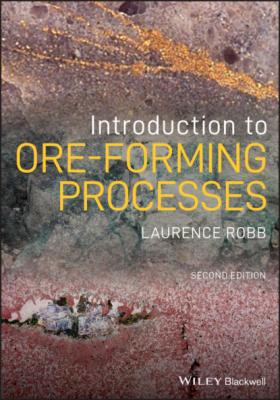Introduction to Ore-Forming Processes. Laurence Robb
Читать онлайн.| Название | Introduction to Ore-Forming Processes |
|---|---|
| Автор произведения | Laurence Robb |
| Жанр | География |
| Серия | |
| Издательство | География |
| Год выпуска | 0 |
| isbn | 9781119232384 |
Silicates
The bulk of the Earth's crust and mantle is made up of silicate minerals that can be subdivided into several mineral series based on the structure and coordination of the tetrahedral
Tekto (framework)
1 Quartz – SiO2
2 Orthoclase – (K,Na)AlSi3O8
3 Albite – (Na,Ca)AlSi3O8
4 Scapolite – (Na,Ca)4(Al,Si)4O8)3 (Cl, CO3)
5 Zeolite (analcime) – NaAlSi2O6·H2O
Neso (ortho)
1 Zircon – Zr(SiO4)
2 Garnet (almandine) – Fe3Al2(SiO4)3
3 Garnet (grossular) – Ca3Al2(SiO4)3
4 Sillimanite – Al2SiO5
5 Topaz – Al2SiO4(F,OH)2
6 Chloritoid – (Fe,Mg,Mn)2(Al,Fe)Al3O2(SiO4)2(OH)4
Cyclo (ring)
1 Beryl – Be3Al2Si6O18
2 Tourmaline – (Na,Ca)(Mg,Fe,Mn,Al)3(Al,Mg,Fe)6Si6O18(BO3)3(OH,F)4
Soro (di)
1 Lawsonite – CaAl2Si2O7(OH)2·H2O
2 Epidote – Ca2(Al,Fe)3Si3O12(OH)
Phyllo (sheet)
1 Kaolinite – Al4Si4O10(OH)8
2 Montmorillonite – (Na,Ca)0.3(Al,Mg)2Si4O10(OH)2·nH2O
3 Illite – KAl2(Si,Al)4O10(H2O)(OH)2
4 Pyrophyllite – Al2Si4O10(OH)2
5 Talc – Mg3Si4O10(OH)2
6 Muscovite – KAl2(AlSi3O10)(OH)2
7 Biotite – K(Fe,Mg)3(Al,Fe)Si3O10(OH,F)2
8 Lepidolite – K(Li,Al)3(Si,Al)4O10(OH,F)2
9 Chlorite – (Fe,Mg,Al)5–6(Si,Al)4O10(OH)8
Ino (chain)
1 Tremolite‐actinolite – Ca2(Fe,Mg)5Si8O22(OH)2
2 Spodumene – LiAlSi2O6
3 Wollastonite – CaSiO3
Unknown Structure
1 Chrysocolla – (Cu,Al)2H2Si2O5(OH)4·nH2O
Geological Time Scale
The development of a geological time scale has been the subject of a considerable amount of thought and research over the past few decades and continues to occupy the minds and activities of stratigraphers and geochronologists around the world. The definition of a framework within which to describe the secular evolution of rocks, and hence the Earth, has been, and continues to be, a contentious exercise. The International Commission on Stratigraphy (ICS is a working group of the International Union of Geological Sciences: IUGS) has assumed the official role of developing the geological time scale, a task that is continuously being modified and improved upon. The work of the ICS is periodically published as a book, such as Harland's (1989) seminal A Geologic Time Scale – which has now been superseded a number of times by works such as Gradstein et al. (2004 and 2012) and Ogg et al. (2016). In these books reference is made to the timing of various events and processes and the provision of a time scale to which readers can refer. Figure 5 is a time scale based on the 2018 version of the International Stratigraphic Chart, published and sanctioned by the ICS and IUGS (http://www.stratigraphy.org). In this diagram global chronostratigraphic terms are presented in terms of eons, eras, periods, and epochs, and defined by absolute ages in millions of years before present (Ma). Also shown are the approximate positions on the time scale of many of the ore deposits and metallogenic provinces referred to in the text.
Figure 5 Geological time scale after the International Commission on Stratigraphy (http://www.stratigraphy.org/index.php/ics-chart-timescale). Also shown are the ages of the various deposits and metallogenic provinces mentioned in the book.
Natural Resources, Sustainability, and the Environment
One of the major issues that characterized social and economic development toward the end of the twentieth century revolved around the widespread acceptance that the Earth's natural resources are finite, and that their exploitation should be carried out in a manner that will not detrimentally affect future generations. The concept of “sustainable development” in terms of the exploitation of mineral occurrences implies that current social and economic practice should endeavor not to deplete natural resources to the point where the needs of the future cannot be met. This would seem to be an impossible goal given the unprecedented population growth over the past century and the fact that many commodities may become depleted within the next 100 years. The challenge for commodity supply over the next century is a multifaceted one and will require a better understanding of the Earth system, improved incentives to promote more efficient recycling of existing resources, and the means to find alternative sources for commodities that are in danger of depletion.
There has been a dramatic rise in global population over the past 150 years. The number of humans on Earth has risen from one billion in 1830 to over seven billion at the start of the twenty‐first century. Most predictions suggest that the populations of most countries will start to level off over the next 30 years and that global numbers will stabilize at around eleven billion people by the end of the twenty‐first century. Societies in the next 100 years are, nevertheless, facing a scenario in which the demand for, and utilization of, natural resources continues to increase, and certain commodities might well become depleted in this interval. Production trends for commodities such as oil, bauxite, copper, and gold (Figure 6) confirm that demand for resources reflects population growth and is likely to continue to do so over the next few decades. World oil production increased precipitously until the late 1970s, but since then a variety of political and economic factors have contributed to moderating demand (Figure 6a), thereby ensuring a longer‐term reserve base. A similar leveling of production is evident for bauxite (Figure 6b) but such a trend is not yet evident for the precious metals such as gold or platinum. For some commodities, such as copper
